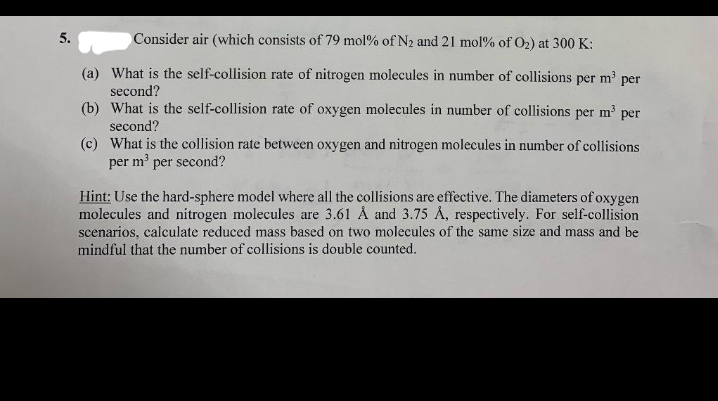5. Consider air (which consists of 79 mol% of N2 and 21 mol% of O2) at 300 K: (a) What is the self-collision rate of nitrogen molecules in number of collisions per m³ per second? (b) What is the self-collision rate of oxygen molecules in number of collisions per m' per second? (c) What is the collision rate between oxygen and nitrogen molecules in number of collisions per m' per second? Hint: Use the hard-sphere model where all the collisions are effective. The diameters of oxygen molecules and nitrogen molecules are 3.61 Å and 3.75 Å, respectively. For self-collision scenarios, calculate reduced mass based on two molecules of the same size and mass and be mindful that the number of collisions is double counted.
5. Consider air (which consists of 79 mol% of N2 and 21 mol% of O2) at 300 K: (a) What is the self-collision rate of nitrogen molecules in number of collisions per m³ per second? (b) What is the self-collision rate of oxygen molecules in number of collisions per m' per second? (c) What is the collision rate between oxygen and nitrogen molecules in number of collisions per m' per second? Hint: Use the hard-sphere model where all the collisions are effective. The diameters of oxygen molecules and nitrogen molecules are 3.61 Å and 3.75 Å, respectively. For self-collision scenarios, calculate reduced mass based on two molecules of the same size and mass and be mindful that the number of collisions is double counted.
Chemistry for Engineering Students
4th Edition
ISBN:9781337398909
Author:Lawrence S. Brown, Tom Holme
Publisher:Lawrence S. Brown, Tom Holme
Chapter10: Entropy And The Second Law Of Thermodynamics
Section: Chapter Questions
Problem 10.67PAE
Related questions
Question

Transcribed Image Text:5.
Consider air (which consists of 79 mol% of N2 and 21 mol% of O2) at 300 K:
(a) What is the self-collision rate of nitrogen molecules in number of collisions per m' per
second?
(b) What is the self-collision rate of oxygen molecules in number of collisions per m' per
second?
(c) What is the collision rate between oxygen and nitrogen molecules in number of collisions
per m'
per second?
Hint: Use the hard-sphere model where all the collisions are effective. The diameters of oxygen
molecules and nitrogen molecules are 3.61 Å and 3.75 Å, respectively. For self-collision
scenarios, calculate reduced mass based on two molecules of the same size and mass and be
mindful that the number of collisions is double counted.
Expert Solution
This question has been solved!
Explore an expertly crafted, step-by-step solution for a thorough understanding of key concepts.
Step by step
Solved in 2 steps with 2 images

Knowledge Booster
Learn more about
Need a deep-dive on the concept behind this application? Look no further. Learn more about this topic, chemistry and related others by exploring similar questions and additional content below.Recommended textbooks for you

Chemistry for Engineering Students
Chemistry
ISBN:
9781337398909
Author:
Lawrence S. Brown, Tom Holme
Publisher:
Cengage Learning

Physical Chemistry
Chemistry
ISBN:
9781133958437
Author:
Ball, David W. (david Warren), BAER, Tomas
Publisher:
Wadsworth Cengage Learning,

Chemistry by OpenStax (2015-05-04)
Chemistry
ISBN:
9781938168390
Author:
Klaus Theopold, Richard H Langley, Paul Flowers, William R. Robinson, Mark Blaser
Publisher:
OpenStax

Chemistry for Engineering Students
Chemistry
ISBN:
9781337398909
Author:
Lawrence S. Brown, Tom Holme
Publisher:
Cengage Learning

Physical Chemistry
Chemistry
ISBN:
9781133958437
Author:
Ball, David W. (david Warren), BAER, Tomas
Publisher:
Wadsworth Cengage Learning,

Chemistry by OpenStax (2015-05-04)
Chemistry
ISBN:
9781938168390
Author:
Klaus Theopold, Richard H Langley, Paul Flowers, William R. Robinson, Mark Blaser
Publisher:
OpenStax

Principles of Modern Chemistry
Chemistry
ISBN:
9781305079113
Author:
David W. Oxtoby, H. Pat Gillis, Laurie J. Butler
Publisher:
Cengage Learning

Chemistry: Principles and Reactions
Chemistry
ISBN:
9781305079373
Author:
William L. Masterton, Cecile N. Hurley
Publisher:
Cengage Learning

Chemistry: An Atoms First Approach
Chemistry
ISBN:
9781305079243
Author:
Steven S. Zumdahl, Susan A. Zumdahl
Publisher:
Cengage Learning